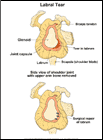
Labral Tear of the Shoulder
What is a labral tear?
The shoulder joint is a ball-and-socket joint. The socket of the shoulder blade holds the ball of the upper arm bone. The socket is called the glenoid. The labrum is a lip of connective tissue located where the shoulder ligaments, which make up the joint capsule, connect to the edge of the socket. Ligaments are strong bands of tissue that attach bone to bone, helping to hold the ball in the socket. The tendon of the biceps muscle in the upper arm attaches to the shoulder just above the labrum. A tear in the labrum can occur during a shoulder or arm injury.
How does it occur?
The labrum can be torn by:
- dislocating your shoulder
- falling onto your arm
- a forced movement of your arm or shoulder
- using your arm to break a fall
- lifting a heavy object
- use of your shoulder in sports with a repetitive, high velocity overhead movement, such as throwing a ball or serving in tennis.
What are the symptoms?
The symptoms of a labral tear are:
- arm and shoulder pain
- arm and shoulder weakness
- painful overhead movements of the shoulder
- clicking or grinding sounds or sensations when you move your shoulder.
How is it diagnosed?
Your health care provider will check your shoulder for pain, tenderness, loss of motion, or joint looseness as you move your arm in all directions. He or she will ask if your shoulder pain began suddenly or gradually. You may have an x-ray to see if there are any fractures in the shoulder.
Your health care provider may recommend that you get an MRI (magnetic resonance imaging) of your shoulder. An MRI is a special scan that shows bone, ligaments, cartilage, and muscle. The MRI may be done with an arthrogram. In an arthrogram, a special dye is injected into the shoulder to outline the structures within the joint, providing a better look at the labrum and other shoulder structures.
You may have an arthroscopy, a surgical procedure in which a small fiber-optic scope is inserted into your shoulder joint so your doctor can see all the structures in your shoulder. Many times, labral tears are finally diagnosed when arthroscopy is performed to look inside a shoulder that has persistently caused pain and other symptoms.
How is it treated?
At first treatment may include:
- putting ice packs on your shoulder for 20 to 30 minutes 3 to 4 times a day
- taking anti-inflammatory medicines such as ibuprofen
- doing shoulder rehabilitation exercises.
Large labral tears usually need to be fixed in surgery. The tear in the labrum may be repaired or the torn parts trimmed away. Any scar tissue may be removed. If you have torn shoulder ligaments, they may be reattached. If you have a small labral tear you may choose to avoid activities that cause shoulder pain rather than have surgery.
When can I return to my sport or activity?
The goal of rehabilitation is to return you to your sport or activity as soon as is safely possible. If you return too soon, you may worsen your injury, which could lead to permanent damage. Everyone recovers from injury at a different rate. Return to your sport or activity is determined by how soon your shoulder recovers, not by how many days or weeks it has been since your injury occurred.
You may safely return to your sport or activity when:
- your injured shoulder has full range of motion without pain
- your injured shoulder has regained normal strength compared to the uninjured shoulder.
In throwing sports, you must gradually build your tolerance to throwing. This means you should start with gentle tossing and gradually throw harder. In contact sports, your shoulder must not be tender to touch, and contact should progress from minimal contact to harder contact.
How can I prevent a labral tear?
Many labral tears are caused by accidents that cannot be prevented. However, it is important to use good form while throwing, playing racquet sports, or lifting heavy objects.

